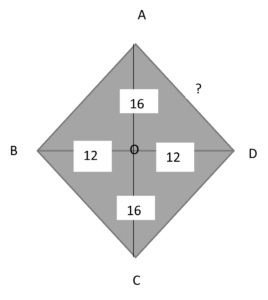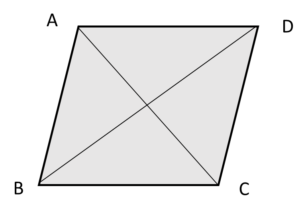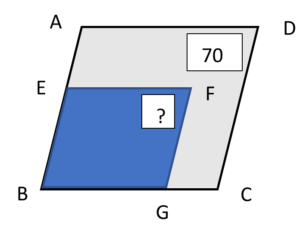Quadrilaterals Class 9 MCQ Questions – Maths Class 9 MCQ Online Test are covered in this Article. Quadrilaterals Class 9 MCQ Test contains 25 questions. Answers to MCQ on Quadrilaterals Class 9 MCQ are available after clicking on the answer. MCQ Questions for Class 9 with Answers have been made for Class 9 students to help check the concept you have learnt from detailed classroom sessions and application of your knowledge.
| Board | CBSE |
| Textbook | Maths (NCERT) |
| Class | Class 9 |
| Chapter | Chapter 8 Quadrilaterals |
| Category | MCQ Questions for Class 9 Maths with Answers |
Quadrilaterals Class 9 MCQ Questions
1. The sum of the angles of a quadrilateral is
(a) 90˚
(b) 180˚
(c) 360˚
(d) 270˚
Answer
Answer: (c) 360˚
2. In a parallelogram ABCD, if AC is a diagonal, then,

(a) ∆ABC is congruent to ∆ADC
(b) ∆ABC is not congruent to ∆ADC
(c) AC bisects parallelogram ABCD
(d) None of the above
Answer
Answer: (a) ∆ABC is congruent to ∆ADC
Explanation: A diagonal of a parallelogram divides it into two congruent triangles.
3. The diagonals of a rhombus
(a) Bisects each other
(b) Bisects each other at 90˚
(c) Are equal
(d) Bisects each other at 90˚ and are equal
Answer
Answer: (b) Bisects each other at 90˚
4. The diagonals of a square
(a) Bisects each other
(b) Bisects each other at 90˚
(c) Are equal
(d) Bisects each other at 90˚ and are equal
Answer
Answer: (d) Bisects each other at 90˚ and are equal
5. In a ∆ABC, D and E are the mid points of AB and AC respectively

(a) DE is parallel to BC
(b) DE = 1/2 BC
(c) AD = 1/2 AB
(d) All of the above
Answer
Answer: (d) All of the above
Explanation: The line segment joining the mid points of any two sides of triangle is parallel to its third side and is half of it.
D is a midpoint of AB
6. A quadrilateral is a parallelogram if
(i) each pair of opposite sides are equal and parallel
(ii) opposite angles are equal
(iii) Diagonals bisect each other
(iv) Diagonals bisect each other at 90˚
(a) i, ii, iv
(b) i, ii
(c) i, ii, iii
(d) i, ii, iii, iv
Answer
Answer: (c) i, ii, iii
7. The diagonals of a rectangle
(i) Bisects each other
(ii) Bisects each other at 90˚
(iii) Are equal
(iv)( Bisects each other at 90˚ and are equal
(a) i, ii
(b) i, iii
(c) iv
(d) ii, iii
Answer
Answer: (b) i, iii
Quadrilaterals Class 9 MCQ Questions
8. Find the incorrect statement
(a) A Parallelogram is a trapezium
(b) A Trapezium is not a parallelogram
(c) A square is a rectangle
(d) A rhombus is a square
Answer
Answer: (d) A rhombus is a square
Explanation: A rhombus is not a square
9. Here, a rectangle and parallelogram with same perimeter, then

(a) Area of rectangle = area of parallelogram
(b) Area of rectangle <area of parallelogram
(c) Area of rectangle > area of parallelogram
Answer
Answer: (c) Area of rectangle > area of parallelogram
Explanation: Area of rectangle = BC × AB
area of parallelogram= BC × AE
Here AB always greater than AE.
10. The angles of quadrilateral are in a ratio of 5:7:4:2. Find each angle.
(a) 20˚,160˚, 60˚, 120˚
(b) 100˚, 140˚, 80˚,40˚
(c) 60˚, 100˚, 80˚, 120˚
(d) 50˚, 160˚, 60˚, 90˚
Answer
Answer: (b) 100˚, 140˚, 80˚,40˚
Explanation: Using, Angle sum property of quadrilateral
∠A+ ∠B+ ∠C+ ∠D = 360˚
5x + 7x + 4x + 2x = 360˚
18x = 360˚
x = 20˚
The angles are 100˚, 140˚, 80˚, 40˚
11. The diagonals of rhombus are 24cm and 32cm. Find the side of rhombus.

(a) 20cm
(b) 14cm
(c) 21cm
(d) 18cm
Answer
Answer: (a) 20cm
Explanation: Diagonals of rhombus bisect each other at 90˚
So, ∆AOD is a right -angled triangle
AD2 = OA2 + OD2
= 162 + 122
= 256 + 144
= 400
AD = 20cm
12. ABCD is a parallelogram, ∠A = 3x + 50˚, ∠C = 7x + 30˚. find x.
(a) 4
(b) 5
(c) 6
(d) 7
Answer
Answer: (b) 5
Explanation: Opposite angles of a parallelogram are equal.
Therefore, ∠A = ∠C
3x+50˚ = 7x+ 30˚
4x = 20
x = 5
13. Find the fourth angle if three angles of a quadrilateral are 60˚, 100˚, 80˚.
(a) 60˚
(b) 100˚
(c) 160˚
(d) 120˚
Answer
Answer: (d) 120˚
Explanation: Using, Angle sum property of quadrilateral
∠A+ ∠B+ ∠C+ ∠D = 360˚
60˚ + 100˚ + 80˚ + x = 360˚
x = 360˚- 240˚
x = 120˚
14. The side of rhombus is 18cm. Find the length of its diagonal when both the diagonals are of equal length.
(a) 18cm
(b) 18√2 cm
(c) 16 cm
(d) 21√2 cm
Answer
Answer: (b) 18√2 cm
Explanation: Diagonals of rhombus bisect each other at 90˚
So, ∆AOD is a right angled triangle
Let the length of diagonals are x cm.
OA =OD = x/2
AD2 = OA2 + OD2
182 = (x/2)2 + (x/2)2
324 = x2/4 + x2/4
324 × 4 = 2x2
=> x2= 324 × 2
=> x = 18√2 cm
15. A quadrilateral having only one pair of sides are equal is a
(a) Trapezium
(b) Square
(c) Rectangle
(d) Rhombus
Answer
Answer: (a) Trapezium
16. The adjacent angles of a parallelogram form
(a) 100˚
(b) 120˚
(c) 180˚
(d) 90˚
Answer
Answer: (c) 180˚
Quadrilaterals Class 9 MCQ Questions
17. A quadrilateral should be a ………..figure of 4 sides
(a) Open
(b) Closed
Answer
Answer: (b) Closed
18. The two adjacent angles of a parallelogram are (3x-5) and (7x +5). Find all the angles.
(a) 131˚, 31˚, 41˚, 101˚
(b) 140˚, 31˚, 11˚, 130˚
(c) 131˚, 149˚, 31˚,41˚
(d) 49˚, 131˚, 49˚, 131˚
Answer
Answer: (d) 49˚, 131˚, 49˚, 131˚
Explanation: The adjacent angles of a parallelogram form linear pair.
3x -5 + 7x +5 = 180˚
10x = 180˚
X = 18˚
1st angle = 3x-5 = 3 × 18 -5 = 49˚
2nd angle = 7x + 5 = 7 × 18 + 5 = 131˚
Opposite angles of parallelogram are equal.
19. Quadrilateral whose diagonals bisect each other at 90˚
(a) Rectangle and square
(b) Rectangle and rhombus
(c) Rhombus and square
(d) Parallelogram and rhombus
Answer
Answer: (c) Rhombus and square
20. Linear pair is
(a) 90˚
(b) 180˚
(c) 360˚
(d) 270˚
Answer
Answer: (b) 180˚
21. The line drawn from the mid point of one side of a triangle ,….. to another side and………the third side.
(a) Bisect, parallel
(b) Parallel, perpendicular
(c) Perpendicular, bisect
(d) Parallel, bisect
Answer
Answer: (d) Parallel, bisect
22. In which fig.. AB is parallel to CD

(a) I
(b) II
(c) Both
(d) None
Answer
Answer: (b) II
Explanation: Fig II, is a parallelogram; Opposite sides are parallel and equal.
AB is parallel to CD and BC is parallel to AD.
Fig I, is a trapezium; only one pair of opposite sides are parallel i.e., AD is parallel to BC
23. Name the congruent triangles.

(i) ∆ABC and ∆ADC
(ii) ∆ABC and ∆BDC
(iii)∆ABD and ∆BDC
(iv) ∆ACD and ∆ADC
(a) i, ii
(b) ii, iii
(c) i, iii
(d) iii, iv
Answer
Answer: (c) i, iii
Explanation: The diagonals of a parallelogram divide it into two congruent triangles.
AC divides ∆ABC and ∆ADC
BD divides ∆ABD and ∆BDC
24. Find ∠F.

(a) 70˚
(b) 60˚
(c) 90˚
(d) 110˚
Answer
Answer: (a) 70˚
Explanation: Opposite angles of parallelogram are equal.
In parallelogram ABCD,
∠B = ∠D = 70˚
In parallelogram EFGB,
∠B = ∠ F = 70˚
25. The bisector of two angles forming linear pair is
(a) 180˚
(b) 60˚
(c) 90˚
(d) 120˚
Answer
Answer: (c) 90˚
MCQ Questions for Class 9 Maths
- Number Systems Class 9 MCQ with Answers
- Polynomials Class 9 MCQ with Answers
- Coordinate Geometry Class 9 MCQ Questions
- Linear Equations in Two Variables Class 9 MCQ with Answers
- Lines and Angles Class 9 MCQ with Answers
- Triangles Class 9 MCQ with Answers
- Quadrilaterals Class 9 MCQ Questions
- Circles Class 9 MCQ with Answers
- Constructions Class 9 MCQ
- Heron’s Formula Class 9 MCQ with Answers
- Surface Area and Volume Class 9 MCQ
- Statistics Class 9 MCQ
- Probability Class 9 MCQ with Answers
Frequently Asked Questions on Quadrilaterals Class 9 MCQ Questions
1. Are these MCQ on Quadrilaterals Class 9 are based on 2021-22 CBSE Syllabus?
Yes. There are 25 MCQ’s on this Chapter in this blog.
2. Are you giving all the chapters of Maths Class 9 MCQs with Answers which are given in CBSE syllabus for 2021-22 ?
Yes, we are providing all the chapters of Maths Class 9 MCQs with Answers.